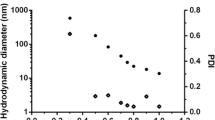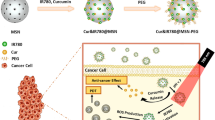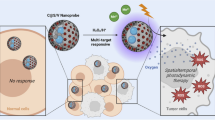Abstract
In the present study, we demonstrated the use of nanoporous zinc oxide (ZnO NPs) in photodynamic therapy. The ZnO NPs structure possesses a high surface to volume ratio due to its porosity and ZnO NPs can be used as an efficient photosensitizer carrier system. We were able to grow ZnO NPs on the tip of borosilicate glass capillaries (0.5 μm diameter) and conjugated this with Photofrin for efficient intracellular drug delivery. The ZnO NPs on the capillary tip could be excited intracellularly with 240 nm UV light, and the resultant 625 nm red light emitted in the presence of Photofrin activated a chemical reaction that produced reactive oxygen species (ROS). The procedure was tested in A-549 cells and led to cell death within a few minutes. The morphological changes in necrosed cells were examined by microscopy. The viability of control and treated A-549 cells with the optimum dose of UV/visible light was assessed using the MTT assay, and ROS were detected using a fluorescence microscopy procedure.





Similar content being viewed by others
References
Wilson BC, Patterson MS, Lilge L (1997) Implicit and explicit dosimetry in photodynamic therapy: a new paradigm. Lasers Med Sci 12:182–199
Kishwar S, Asif MH, Nur O, Willander M, Larsson PO (2010) Intracellular ZnO nanorods conjugated with protoporphyrin for local mediated photochemistry and efficient treatment of single cancer cell. Nanoscale Res Lett 5:1669–1674
Lopez T, Ortiz E, Alvarez M, Navarrete J, Odriozola JA, Ortega FM, Mozo EA, Escobar P, Espinoza KA, Rivero IA (2010) Study of the stabilization of zinc phthalocyanine in sol-gel TiO2 for photodynamic therapy applications. Nanomedicine 6:777–786
Koo OM, Rubinstein I, Onyuksel H (2005) Role of nanotechnology in targeted drug delivery and imaging: a concise review. Nanomedicine 1:193–212
Wang M, Thanou M (2010) Targeting nanoparticles to cancer. Pharmacol Res 62:90–99
Stupp SI (2005) Introduction: functional nanostructures. Chem Rev 105:1023–1024
Emerich DF, Thanos CG (2006) The pinpoint promise of nanoparticle-based drug delivery and molecular diagnosis. Biomol Eng 23:171–184
Roduner E (2006) Size matters: why the nanomaterials are different. Chem Soc Rev 35:583–592
Allison RR, Sibata C, Downie GH, Cuenca RE (2006) Photodynamic therapy of the intact breast. Photodiagn Photodyn Ther 3:139–146
DeRosa MC, Crutchley RJ (2002) Photosensitized singlet oxygen and its applications. Coord Chem Rev 233:351–371
Bonnett R (2002) Progress with heterocyclic photosensitizers for the photodynamic therapy of tumours. J Heterocyclic Chem 39:455–470
Bonnett R, Martínez G (2001) Photobleaching of sensitisers used in photodynamic therapy. Tetrahedron 57:9513–9547
Castano AP, Demidova TN, Hamblin MR (2004) Mechanisms in photodynamic therapy: part one-photosensitizers, photochemistry and cellular localization. Photodiagn Photodyn Ther 1:279–293
Atif M, Stringer MR, Cruse-Sawyer JE, Brown SB (2003) Intracellular fluorescence photobleaching dynamics of mTHPC. Lasers Med Sci 18:S51
Berlanda J, Kiesslich T, Oberdanner CB, Obermair FJ, Krammer B, Plaetzer K (2006) Characterization of apoptosis induced by photodynamic treatment with hypericin in A431 human epidermoid carcinoma cells. J Environ Pathol Toxicol Oncol 25:173–188
Atif M (2006) PDT photosensitizer concentration effects upon photobleaching dynamics. Proceedings of the 6th International Symposium on Photodynamic Diagnosis and Therapy in Clinical Practice, Italy
Atif M, Dyer PE, Snelling HV, Paget T, Stringer MR (2007) Two-photon excitation studies of mTHPC photosensitizer and photodynamic activity in an epithelial cell line. Photodiagn Photodyn Ther 4:106–111
Atif M, Firdous S, Khurshid A, Noreen L, Zaidi SSZ, Ikram M (2009) In vitro study of 5 aminolevulinic acid (5-ALA) based photodynamic therapy for apoptosis in human cervical HeLa cell line. Laser Phys Lett 6:886–891
Khurshid A, Atif M, Firdous S, Zaidi SSZ, Salman R, Ikram M (2010) Photodynamic therapy of human larynx squamous cell carcinoma (Hep2c) using 5-aminolevulanic acid in vitro. Laser Phys 20:1673–1678
Atif M, Alam MF, Firdous S, Zaidi SSZ, Salman R, Ikram M (2010) Study of the efficacy of 5ALA-mediated photodynamic therapy on human rhabdomyosarcoma cell line (RD). Laser Phys Lett 7:757–764
Atif M, Firdous S, Nawaz M (2010) Laser induced effects in different biological samples. Lasers Med Sci 25:545–550
Alam MF, Atif M, Alsalhi MS, Siddique M, Kishwar S, Qadir MI (2011) Role of ALA sensitivity in HepG2 cell in the presence of diode laser. Laser Phys 21:1–9
Ullah H, Atif M, Firdous S, Mehmood MS, Ikram M, Kurachi C, Grecco C, Nicolodelli G, Bagnato VS (2010) Femtosecond light distribution at skin and liver of rats: analysis for use in optical diagnostics. Laser Phys Lett 7:889–898
Fulati A, Ali SM, Asif MH, Alvi NH, Willander M, Brännmark C, Strålfors P, Börjesson SI, Elinder F, Danielsson B (2010) An intracellular glucose biosensor based on nanoflake ZnO. Sens Actuators B 150:673–680
Alvi NH, Ali SM, Hussain S, Nur O, Willander M (2011) Fabrication and comparative optical characterization of n-ZnO nanostructures (nanowalls, nanorods, nanoflowers and nanotubes)/p-GaN white light emitting diodes. Scripta Materiala 64:697–700
Alam MF, Roohi S, Atif M, Firdous S, Amir N, Zahoor R (2010) Labelling and optimization of PHOTOFRIN® with 99mTc. Radiochim Acta 98:813–818
Guo D, Wu C, Jiang H, Li Q, Wang X, Chen B (2008) Synergistic cytotoxic effect of different sized ZnO nanoparticles and daunorubicin against leukemia cancer cells under UV irradiation. J Photochem Photobiol B 93:119–126
Alam MF, Kishwar S, Khan Y, Siddique M, Atif M, Nur O, Willander M (2011) Tumoricidal effects of nanomaterials in HeLa cell line. Laser Phys. doi:10.1134/S1054660X1119011
Chan WC, Nie S (1998) Quantum dot bio conjugates for ultrasensitive nonisotopic detection. Science 281:2016–2018
Kolarova H, Bajgar R, Tomankova K, Krestyn L, Dolezal L, Halek J (2007) In vitro study of reactive oxygen species production during photodynamic therapy in ultrasound-pretreated cancer cells. Physiol Res 56(suppl 1):S27–S32
Nel A, Xia T, Madler L, Li L (2006) Toxic potential of materials at the nano-level. Science 311:625–627
Li Y, Tian X, Lu Z, Yang C, Yang G, Zhou X, Uao H, Zhu Z, Xi Z, Yang X (2010) Mechanism for alpha MnO2 nanowire-induced cytotoxicity in HeLa cells. J Nanosci Nanotechnol 10:397–404
Zhu MT, Feng WY, Wang B, Wang TC, Gu YQ, Wang M, Yang HQ, Zhao YL, Chai ZF (2008) Comparative study of pulmonary responses to nano- and submicron-sized ferric oxide in rats. Toxicology 247:102–111
Lin W, Xu Y, Huang CC, Ma Y, Shannon KB, Chen DR, Huang YW (2009) Toxicity of nano and micro-sized ZnO particles in human lung epithelial cells. J Nanopart Res 11:25–39
Hirano S, Higo S, Tsukamoto N, Kobayashi E, Suzuki KT (1989) Pulmonary clearance and toxicity of zinc oxide instilled into the rat lung. Arch Toxicol 63:336–342
Baek M, Kim MK, Cho HJ, Lee JA, Yu J, Chung HE, Choi SJ (2011) Factors influencing the cytotoxicity of zinc oxide nanoparticles: particle size and surface charge. J Phys Conf Ser 304:012044
Moos PJ, Chung K, Woessner D, Honeggar M, Cutler NS, Veranth JM (2010) ZnO particulate matter requires cell contact for toxicity in human colon cells. Chem Res Toxicol 23:733–739
Waters KM, Masiello LM, Zangar RC, Tarasevich BJ, Karin NJ, Quesenberry RD, Bandyopadhyay S, Teeguarden JG, Pounds JG, Thrall BD (2009) Macrophage responses to silica nanoparticles are highly conserved across particle sizes. Toxicol Sci 107:553–569
Liu CH, Lee CT, Tsai FC, Hsu SJ, Yang PM (2006) Gastroduodenal corrosive injury after oral zinc oxide. Ann Emerg Med 47:296
Lindahl M, Leanderson P, Tagesson C (1998) Novel aspect on metal fume fever: zinc stimulates oxygen radical formation in human neutrophils. Hum Exp Toxicol 17:105–110
Gordon T, Chen LC, Fine JM, Schlesinger RB, Su WY, Kimmel TA, Amdur MO (1992) Pulmonary effects of inhaled zinc oxide in human subjects, guinea pigs, rats, and rabbits. Am Ind Hyg Assoc J 53:503–509
Lam HF, Chen LC, Ainsworth D, Peoples S, Amdur MO (1988) Pulmonary function of guinea pigs exposed to freshly generated ultrafine zinc oxide with and without spike concentrations. Am Ind Hyg Assoc J 49:333–341
Conner MW, Flood WH, Rogers AE, Amdur MO (1988) Lung injury in guinea pigs caused by multiple exposures to ultrafine zinc oxide: changes in pulmonary lavage fluid. J Toxicol Environ Health 25:57–69
Lam HF, Conner MW, Rogers AE, Fitzgerald S, Amdur MO (1985) Functional and morphologic changes in the lungs of guinea pigs exposed to freshly generated ultrafine zinc oxide. Toxicol Appl Pharmacol 78:29–38
Sax NI, Lewis RJ (1989) Dangerous properties of industrial materials, 7th edn. Van Nostrand Reinhold, New York
Lomer MC, Hutchinson C, Volkert S, Greenfield SM, Catterall A, Thompson RP, Powell JJ (2004) Dietary sources of inorganic microparticles and their intake in healthy subjects and patients with Crohn’s disease. Br J Nutr 92:947–955
Lomer MC, Thompson RP, Powell JJ (2002) Fine and ultrafine particles of the diet: influence on the mucosal immune response and association with Crohn’s disease. Proc Nutr Soc 61:123–130
Lomer MC, Harvey RS, Evans SM, Thompson RP, Powell JJ (2001) Efficacy and tolerability of a low microparticle diet in a double blind, randomized, pilot study in Crohn’s disease. Eur J Gastroenterol Hepatol 13:101–106
Powell JJ, Harvey RS, Ashwood P, Wolstencroft R, Gershwin ME, Thompson RP (2000) Immune potentiation of ultrafine dietary particles in normal subjects and patients with inflammatory bowel disease. J Autoimmun 14:99–105
Lomer MC, Grainger SL, Ede R, Catterall AP, Greenfield SM, Cowan RE, Vicary FR, Jenkins AP, Fidler H, Harvey RS, Ellis R, McNair A, Ainley CC, Thompson RP, Powell JJ (2005) Lack of efficacy of a reduced microparticle diet in a multi-centred trial of patients with active Crohn’s disease. Eur J Gastroenterol Hepatol 17:377–384
Li J, Guo D, Wang X, Wang H, Jiang H, Chen B (2010) The photodynamic effect of different size ZnO nanoparticles on cancer cell proliferation in vitro. Nanoscale Res Lett 5:1063–1071
Acknowledgment
M. Fakhar-e-Alam is grateful for financial support from the Higher Education Commission (HEC), Islamabad, Pakistan.
Author information
Authors and Affiliations
Corresponding author
Rights and permissions
About this article
Cite this article
Fakhar-e-Alam, M., Ali, S.M.U., Ibupoto, Z.H. et al. Sensitivity of A-549 human lung cancer cells to nanoporous zinc oxide conjugated with Photofrin. Lasers Med Sci 27, 607–614 (2012). https://doi.org/10.1007/s10103-011-0989-8
Received:
Accepted:
Published:
Issue Date:
DOI: https://doi.org/10.1007/s10103-011-0989-8




